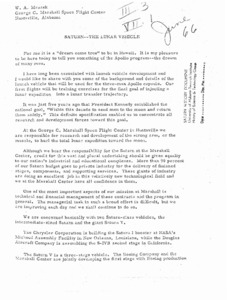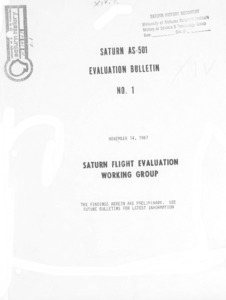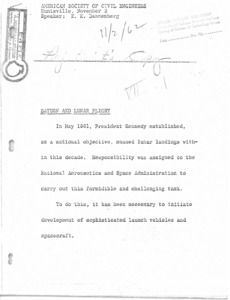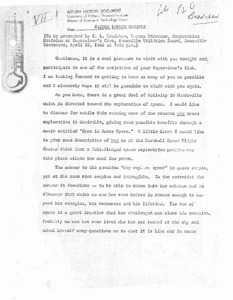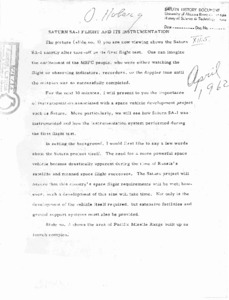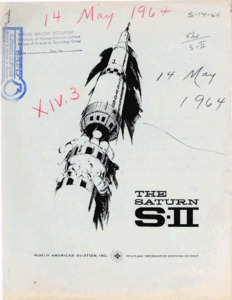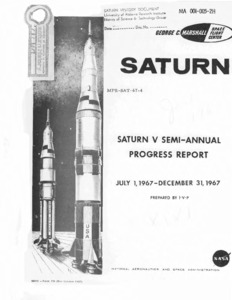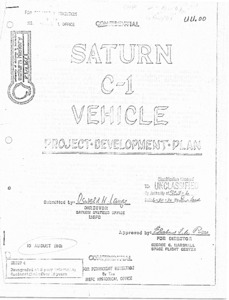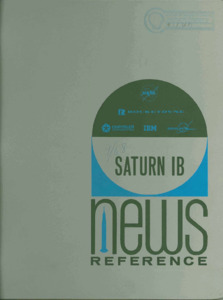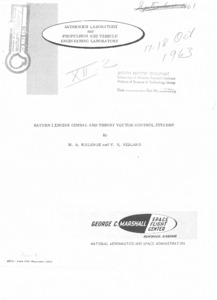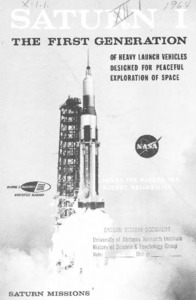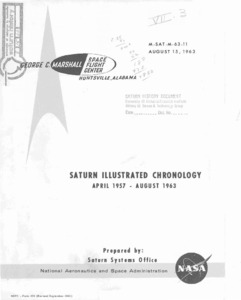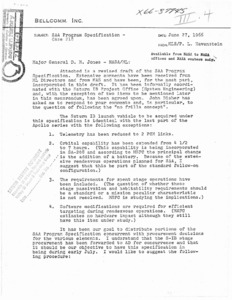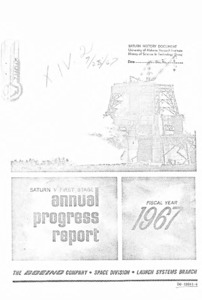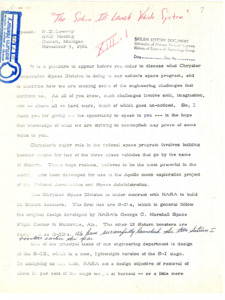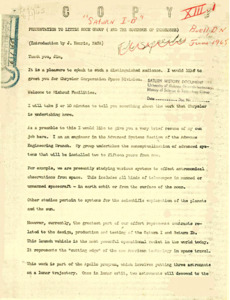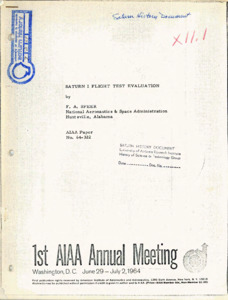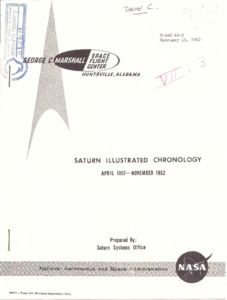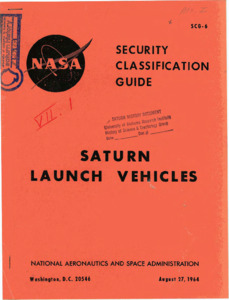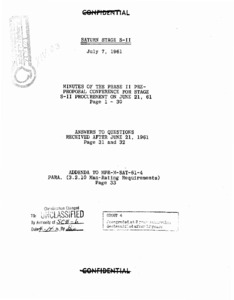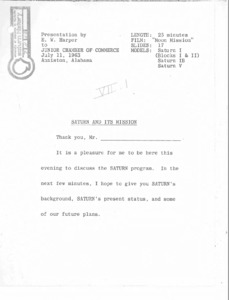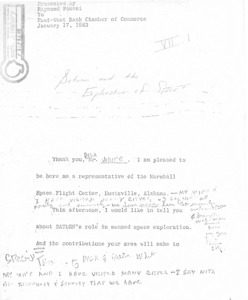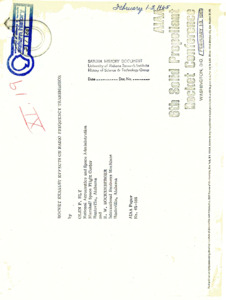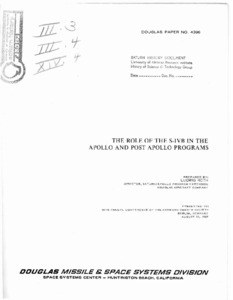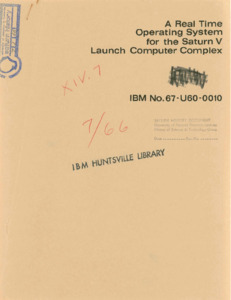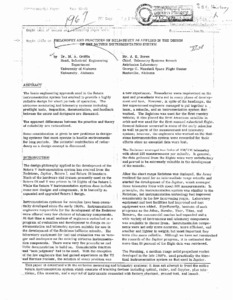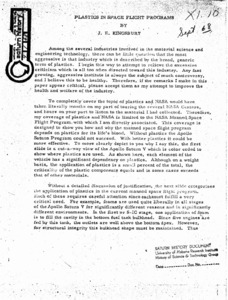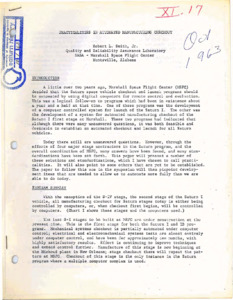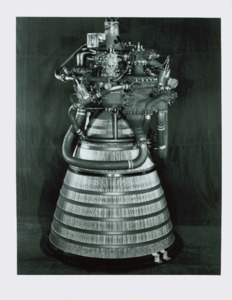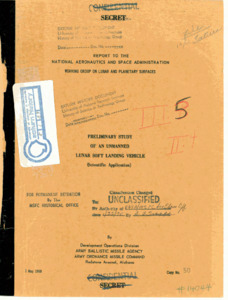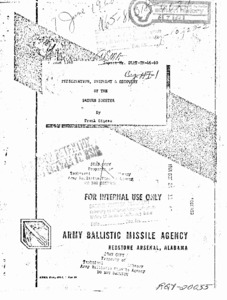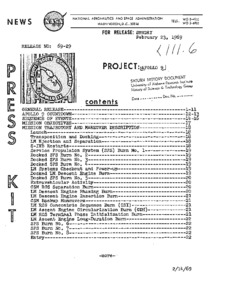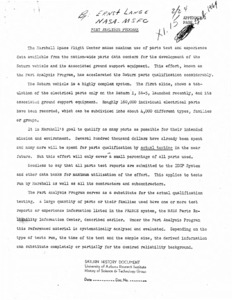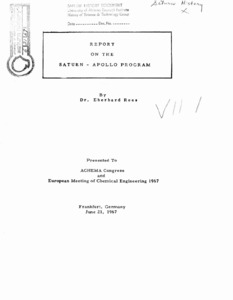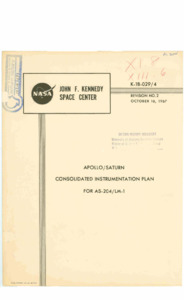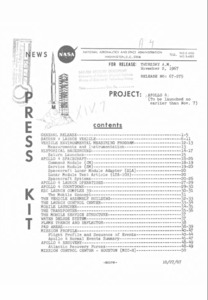
Browse Items (175 total)
Sort by:
-
"The Saturn launch vehicle family."
Presentation focusing on the history of Saturn V's engineering history and crew. -
"Saturn -- the lunar vehicle."
Aerospace Workshop, University of Hawaii.; Includes references to slides. -
Saturn AS-501 evaluation bulletin No. 1, November 14, 1967.
The findings herein are the results of the combined evaluation efforts of the various Laboratories of Research and Development Operations at MFSC, The Boeing Company, North American Rockwell/Space Division, Douglas Aircraft Company, International Business Machines, and Rocketdyne. -
Saturn and lunar flight.
Speech by K.K. Dannenberg at American Society of Civil Engineers, Huntsville, November 2.; Projectionist's copy (photocopy) - slide numbers are included. -
"Saturn launch vehicle presentation."
Speech to be presented by C. L. Bradshaw, Deputy Director, Computation Division at Supervisor's Club, Knoxville Utilities Board. Speech praising the progress of space-based technologies and advancements. -
"Saturn SA-1 flight and its instrumentation."
Presentation focusing on empahsising the importance of space programs such as Saturn. -
"The Saturn S-II."
The S-II is the second stage of NASA's Apollo moon-landing rocket - the giant Saturn V. The most powerful hydrogen-fueled booster under production, the S-II is destined for Apollo manned lunar missions and will help power three Americans to the moon. The S-II is being developed and manufactured at Seal Beach, Calif., by North American's Space and Information Systems Division, Downey, Calif., under the technical direction of NASA's Marshall Space Flight Center, Huntsville, Ala. -
"Saturn V semi-annual progress report July - December, 1967."
This Saturn V Semi-Annual Progress Report describes progress and major achievements from July 1, 1967 in the Saturn V Program. -
"Saturn C-1 vehicle project development plan."
The Saturn C-1 space vehicle system is being developed by government agencies at industrial firms under the direction of the National Aeronotics and Space Division -
"Section III of Saturn C-1 vehicle project development plan."
Plan for the development and construction of the Saturn C-1 vehicle. -
"Saturn IB news reference."
Images, decriptions, graphics and explanations of the various Saturn rockets. -
"Saturn I engine gimbal and thrust vector control systems."
The hydraulic systems for the two-stage block II Saturn I vehicle are described with the evolution of their development. -
"Saturn I : the first generation of heavy launch vehicles designed for peaceful exploration of space."
A basic description of the Saturn rockets alongside diagrams for context. -
"Saturn illustrated chronology : April 1957 - August 1963."
A list of images with detailed descriptions of what they are and their histories. -
"SAA program specification - case 218."
Memo sent to Major General D. M. Jones - NASA/ML. -
"Annual progress report :1966-1967."
The Annual Progress Report from July 1st, 1966 through June 30thm 1967. -
"The Saturn IB launch vehicle system."
Speech containing information regarding Crystler's role in the Saturn Project as contracted builders of the stages of three space vehicles. -
"Saturn IB : presentation to Little Rock Group."
Speech by H.D. Lowrey, SAE Meeting, Detroit, Michigan. Focuses on the Apollo project, the technology involved and what the goals of the project are. -
"Saturn IB/V instrument unit."
This brochure provides some basic, general information about the lnstrument Unit, a very important part of the Saturn IB and Saturn V launch vehicles. These launch vehicles are being developed primarily for the Apollo program for manned lunar exploration but will also be used for future space missions. -
"Saturn I flight test evaluation."
As this paper is being written, the Saturn I flight test program includes five flights launched between October, 1961 and January, 1964. All five fiights were complete successes, both in achieving all major test missions and in obtaining an unprecedented volume of system performance data for flight analysis. -
"Saturn illustrated chronology : April 1957 - November 1962."
Document detailing the history of the saturn project between April, 1957 through November, 1962. -
"Saturn launch vehicles : security classification guide."
This security classification guide is a compilation of previous individual classification assignments. Consideration of international affairs, the use and development of advanced technological information, and requirements of flight safety have influenced these assignments. -
"Saturn stages S-II : July 7, 1961 : Minutes of the phase II pre-proposal conference for stage S-II procurement."
Transcription of a confrence aiming to propose ideas for new rocket designs. Includes references to slides. -
"Saturn and its mission."
Presentation from Harper, discussing the Saturn Project's then-status, background and plans. -
"Saturn and the exploration of space."
Presentation Raymond Pisani to the East-West Bank Chamber of Commerce regarding the Saturn project's roll in space exploration and what contrabutions the East-West Bank can make in that area. -
"Rocket exhaust effects on radio frequency transmission."
Presented by Olen P. Ely, National Aeronautics and Space Administration, Marshall Space Flight Center, Huntsville, Alabama and R. W. Hockenberger, International Business Machines. Paper that explores the effects of rocket-engine exhaust on radio-signals. -
"The role of the S-IVB in the Apollo and past Apollo programs."
Douglas Paper No. 4396.; Prepared by Ludwig Roth, Director, Saturn/Apollo Program Extension, Douglas Aircraft Company.; Presented to 16th Annual Conference of the Hermann Oberth Society. Discusses the role of the Apollo rocket after the Apollo program has concluded. -
"A real time operating system for the Saturn V launch computer system."
Presentation aimed to encourage a final check on the Saturn V project before its first launch to ensure safety and success. -
"Philosophy and practices of reliability as applied in the design of the Saturn Instrumentation System."
The basic engineering approach used in the Saturn instrumentation system has evolved to provide a highly reliable design for short periods of operation. The airborne measuring and telemetry systems including preflight tests, inspection, documentation, and feedback between the users and designers are discussed. The apparent differences between the practice and theory of reliability are rationalized. Some consideration is given to new problems in designing systems that must operate in hostile environments for long periods. The potential contribution of redundancy as a design concept is discussed.; This paper is concerned with the airborne measuring and telemetry systems; it does not attempt to treat the entire Saturn instrumentation system which consists of tracking devices including optical, radar, and Doppler, plus television, film cameras, and a myriad of instruments connected with factory checkout, ground test, and launch. -
"Plastics in space flight programs."
Article aimed at improving the NASA's ability to complete its projects." -
"Practicalities in automated manufacturing checkout."
This paper presents a number of solutions to a number of unanswered questions regarding the Saturn projects. -
"Pratt & Whitney Aircraft RL10 liquid hydrogen rocket engine."
Photograph of a liquid hydrogen rocket engine. -
"Preliminary study of an unmanned lunar soft landing vehicle (Scientific Application)."
Report to the National Aeronautics and Space Administration Working Group on Lunar and Planetary Surfaces. -
Preservation, shipment & recovery of the Saturn booster.
The purpose of this report is to present the shipping and recovery procedures for the Saturn booster. -
"Apollo 9 carries lunar module."
Press release surrounding the Apollo 9 rocket and its crew prior to launch. -
"Organization of a countdown"
The Organization of a Countdown was developed over 8 years of missiles and space systems testing at the Douglas Aircraft Company, Sacramento test Center. The experience on which this study was based includes the Thor development and acceptance testing, Titan I second stage engine development testing, Development of liquid hydrogen handling techniques, Saturn S-IV and S-IVB development and acceptance testing. The intent of this paper is to examine the static test countdown organization and discuss the need for a systematic method to organize a countdown. -
"Part analysis program."
Includes carbon copy of letter sent to David L. Christensen from Ernst Lange regarding the Part Analysis program. -
"Report on the Saturn-Apollo program."
Presented to ACHEMA Congress and European Meeting of Chemical Engineering 1967, Frankfurt, Germany, June 21, 1967 by Dr. Eberhard Rees.; Includes slide numbers. -
"Apollo/Saturn consolidated instrumentation plan for AS-204/LM-1."
This report represents the consolidated instrumentation plan for employing optical and electronic data acquisition systems to monitor the performance and trajectory of the Apollo/Saturn 1B vehicle, AS-2 04/LM-1, during powered flight. Telemetry and electronic tracking equipment on board the vehicle, and data acquisition systems monitoring the flight are discussed. Flight safety instrumentation and vehicle data transmission are described, and geophysical information is provided. This plan reflects the general instrumentation coverage requirements set forth in the NASA Program Support Requirements Document (PSRD) for Apollo/Saturn 16, and the commitments of Eastern Test Range (ETR) Operations Directive (OD) No. 4206,dated 15 August 1967. This plan is not intended to conflict with or to supersede either document. The information presented in this document reflects planning concepts developed prior to October 1, 1967. -
"Apollo 4 press kit."
The flrst flight test of the Apollo/Saturn V space vehicle is scheduled for launch from the Natlonal Aeronautics and Space Administration's John F, Kennedy Space Center, Fla., no earlier than Nov. 7. The mission is designated Apollo 4.

